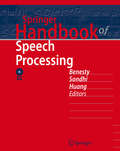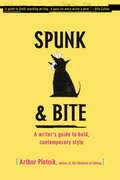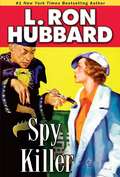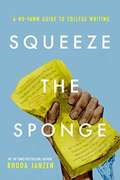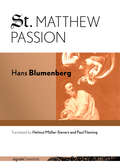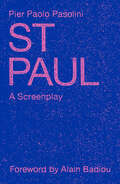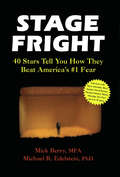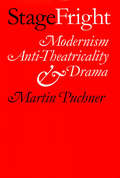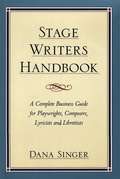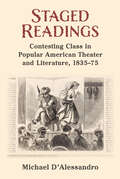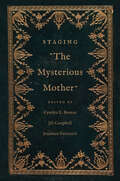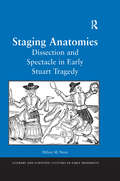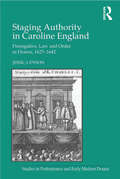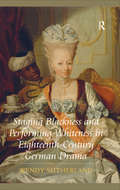- Table View
- List View
Springer Handbook of Speech Processing
by M. M. Sondhi Jacob Benesty Yiteng HuangThis handbook plays a fundamental role in sustainable progress in speech research and development. With an accessible format and with accompanying DVD-Rom, it targets three categories of readers: graduate students, professors and active researchers in academia, and engineers in industry who need to understand or implement some specific algorithms for their speech-related products. It is a superb source of application-oriented, authoritative and comprehensive information about these technologies, this work combines the established knowledge derived from research in such fast evolving disciplines as Signal Processing and Communications, Acoustics, Computer Science and Linguistics.
Spunk and Bite: A Writer's Guide to Bold, Contemporary Style
by Arthur PlotnikSticking to the rules creates boring text that cannot get out of its own way and let the concepts through, so Plotnik sticks to what works in real life. The result is not just a solid guide to usage and composition, but also a source of inspiration. For this edition Plotnik provides an all-new set of writing exercises that work in creating crisp novels, fiction writing, business reports and even blogs. Annotation ©2007 Book News, Inc. , Portland, OR (booknews. com)
Spy Killer
by L. Ron HubbardDiscover intrigue and suspense. Kurt Reid may be innocent of the murder he's charged with (and of grand larceny, for that matter), but he's got no time to be thrown in jail and defend himself. Instead, Reid flees to pre-Communist China and Shanghai, the exotic city of mystery and death.Reid takes refuge in a tea house where he meets White Russian Varinka Savischna, whom he manages to rescue from certain death. As beautiful as she is smart, she recruits him in her crusade against Chinese intelligence services. Unfortunately, Reid manages to get himself captured by the Chinese and blackmailed into pursuing and assassinating a Japanese spy.Now Reid must enter the cloak-and-dagger world of espionage and intrigue, where everything and everyone is not who or what they appear to be. "...novella length adventure-cum-mystery stories based in 1930's China offer further evidence of Hubbard's pulp-action mastery." --Ellery Queen
Squeeze the Sponge: A No-Yawn Guide to College Writing
by Rhoda JanzenThis book uses the author’s powerful, hilarious, and emotionally generous voice as a bestselling memoirist and award-winning professor to offer undergraduate students an inspirational writing guide. This indispensable textbook is replete with hands-on activities, seventy pages of grammar instruction, and memorable tips, examples, and analogies to help students refine their writing—in other words, “squeeze the sponge.” In this book, the author achieves something new: a textbook so lively and humorous that students will actually want to read it.
St. Augustine's Confessions
by Saint Augustine Henry ChadwickIn his own day the dominant personality of the Western Church, Augustine of Hippo today stands as perhaps the greatest thinker of Christian antiquity, and his Confessions is one of the great works of Western literature. In this intensely personal narrative, Augustine relates his rare ascent from a humble Algerian farm to the edge of the corridors of power at the imperial court in Milan, his struggle against the domination of his sexual nature, his renunciation of secular ambition and marriage, and the recovery of the faith his mother Monica had taught him during his childhood. Now, Henry Chadwick, an eminent scholar of early Christianity, has given us the first new English translation in thirty years of this classic spiritual journey. Chadwick renders the details of Augustine's conversion in clear, modern English. We witness the future saint's fascination with astrology and with the Manichees, and then follow him through scepticism and disillusion with pagan myths until he finally reaches Christian faith. There are brilliant philosophical musings about Platonism and the nature of God, and touching portraits of Augustine's beloved mother, of St. Ambrose of Milan, and of other early Christians like Victorinus, who gave up a distinguished career as a rhetorician to adopt the orthodox faith. Augustine's concerns are often strikingly contemporary, yet his work contains many references and allusions that are easily understood only with background information about the ancient social and intellectual setting. To make The Confessions accessible to contemporary readers, Chadwick provides the most complete and informative notes of any recent translation, and includes an introduction to establish the context. The religious and philosophical value of The Confessions is unquestionable--now modern readers will have easier access to St. Augustine's deeply personal meditations. Chadwick's lucid translation and helpful introduction clear the way for a new experience of this classic. About the Series:For over 100 years Oxford World's Classics has made available the broadest spectrum of literature from around the globe. Each affordable volume reflects Oxford's commitment to scholarship, providing the most accurate text plus a wealth of other valuable features, including expert introductions by leading authorities, voluminous notes to clarify the text, up-to-date bibliographies for further study, and much more.
St. Matthew Passion (signale|TRANSFER: German Thought in Translation)
by Hans BlumenbergSt. Matthew Passion is Hans Blumenberg's sustained and devastating meditation on Jesus's anguished cry on the cross, "My God, my God, why have you forsaken me?" Why did this abandonment happen, what does it mean within the logic of the Gospels, how have believers and nonbelievers understood it, and how does it live on in art? With rare philological acuity and vast historical learning, Blumenberg unfolds context upon context in which this cry has reverberated, from early Christian apologetics and heretics to twentieth-century literature and philosophy. Blumenberg's guide through this unending story of divine abandonment is Johann Sebastian Bach's monumental Matthäuspassion, the parabolic mirror that bundled eighteen hundred years of reflection on the fate of the crucified and the only available medium that allows us post-Christian listeners to feel the anguish of those who witnessed the events of the Passion. With interspersed references to writers such as Goethe, Rilke, Kafka, Freud, and Benjamin, Blumenberg gathers evidence to raise the singular question that, in his view, Christian theology has not been able to answer: How can an omnipotent God be so offended by his creatures that he must sacrifice and abandon his own Son?
St. Paul: A Screenplay
by Pier Paolo PasoliniPresented here for the first time in English is a remarkable screenplay about the apostle Paul by Pier Paolo Pasolini, legendary filmmaker, novelist, poet, and radical intellectual activist. Written between the appearance of his renowned film Teorema and the shocking, controversial Salò, or the 120 Days of Sodom, St Paul was deemed too risky for investors. At once a political intervention and cinematic breakthrough, the script forces a revolutionary transformation on the contemporary legacy of Paul. In Pasolini&’s kaleidoscope, we encounter fascistic movements, resistance fighters, and faltering revolutions, each of which reflects on aspects of the Pauline teachings. From Jerusalem to Wall Street and Greenwich Village, from the rise of SS troops to the death of Martin Luther King, Jr, here—as Alain Badiou writes in the foreword—&‘Paul&’s text crosses all these circumstances intact, as if it had foreseen them all&’. This is a key addition to the growing debate around St Paul and to the proliferation of literature centred on the current turn to religion in philosophy and critical theory, which embraces contemporary figures such as Alain Badiou, Slavoj i ek and Giorgio Agamben.
Staar Connection Diagnostic Series Reading 5, Student Edition
by Kamico Instructional MediaThis book is a comprehensive collection of Reading Exercises with related exercises.
Stage Fright: 40 Stars Tell You How They Beat America's #1 Fear
by Mick Berry Michael EdelsteinNever before has the problem of stage fright been so eloquently examined; 40 interviews with some of the most highly-accomplished public figures shed light on this affliction, offering tips from their own experiences for overcoming it. Jason Alexander, Mose Allison, Maya Angelou, David Brenner, Peter Coyote, Olympia Dukakis, Richard Lewis, and many more sound off about their trials with stage fright, candidly discussing their fears and insecurities with life in the public eye and ultimately revealing the various paths they followed to overcoming them. Stage fright sufferers from all walks of life--whether a high school freshman nervous about an oral presentation or a professional baseball player with the eyes of the world on his bat--will find consolation by understanding the commonality of their problem, as well as helpful information to finally shed their inhibitions.
Stage Fright: Modernism, Anti-Theatricality, and Drama
by Martin PuchnerGrounded equally in discussions of theater history, literary genre, and theory, Martin Puchner's Stage Fright: Modernism, Anti-Theatricality, and Drama explores the conflict between avant-garde theater and modernism. While the avant-garde celebrated all things theatrical, a dominant strain of modernism tended to define itself against the theater, valuing lyric poetry and the novel instead. Defenders of the theater dismiss modernism's aversion to the stage and its mimicking actors as one more form of the old "anti-theatrical" prejudice. But Puchner shows that modernism's ambivalence about the theater was shared even by playwrights and directors and thus was a productive force responsible for some of the greatest achievements in dramatic literature and theater.A reaction to the aggressive theatricality of Wagner and his followers, the modernist backlash against the theater led to the peculiar genre of the closet drama—a theatrical piece intended to be read rather than staged—whose long-overlooked significance Puchner traces from the theatrical texts of Mallarmé and Stein to the dramatic "Circe" chapter of Joyce's Ulysses. At times, then, the anti-theatrical impulse leads to a withdrawal from the theater. At other times, however, it returns to the stage, when Yeats blends lyric poetry with Japanese Nôh dancers, when Brecht controls the stage with novelistic techniques, and when Beckett buries his actors in barrels and behind obsessive stage directions. The modernist theater thus owes much to the closet drama whose literary strategies it blends with a new mise en scène. While offering an alternative history of modernist theater and literature, Puchner also provides a new account of the contradictory forces within modernism.
Stage It: Making Shakespeare Come Alive in Schools
by Floyd RumohrStage It provides a simple-to-follow roadmap for teachers to help students dive into the dramatic, romantic, and playful world of Shakespeare. Originating from the highly successful NYC-based arts education program, Stages of Learning, this resource enables your drama, arts, or ELA class to learn the basics of Shakespeare's language, themes, characters, introductory staging, and directing. Designed for busy teachers, Stage It enables you to choose your own adventure depending on time, grade level collaboration, and student interest. This professional teacher’s guide has simple-to-use instructions and worksheets, such as acting tools for instruction about the plot synopsis, cast of characters, and paraphrasing; and directing tools for tips about the play and the theater-making process. Accompanying the book online are abridged versions of four of Shakespeare’s well-known plays: Hamlet, Henry V, Julius Caesar, and Othello, as well as paraphrasing worksheets, a culminating performance program template, and more. Stage It meets or exceeds many standards-based frameworks including New York State Learning Standards in the Arts, benchmarks of the New York City Blueprint for Teaching and Learning in the Arts K-12: Theater, the U.S. Common Core/State Standards, and National Arts Standards. Teachers of students aged 9–12, as well as educators in after-school or community programs, can foster a deep connection to the material through a gradual process that engages everyone in the classroom. This approach not only brings Shakespeare's timeless stories to life but also cultivates essential skills like public speaking, teamwork, and self-expression for students of all identities.For more information on Floyd Rumohr and the book, visit www.stageitplays.com.
Stage Writers Handbook
by Dana SingerDana Singer, Associate Director of America's foremost playwrights' association, the Dramatists Guild, gathers all the information and ideas stage writers need to conduct their careers in a businesslike manner, with all the protections the law provides. Includes chapters devoted to copyright, self-promotion, representation, production contracts, publishing and licensing agreements, underlying rights and collaboration.
Stage and Picture in the English Renaissance: The Mirror up to Nature
by John H. AstingtonThis book presents a new approach to the relationship between traditional pictorial arts and the theatre in Renaissance England. Demonstrating the range of visual culture in evidence from the mid-sixteenth to mid-seventeenth century, from the grandeur of court murals to the cheap amusement of woodcut prints, John H. Astington shows how English drama drew heavily on this imagery to stimulate the imagination of the audience. He analyses the intersection of the theatrical and the visual through such topics as Shakespeare's Roman plays and the contemporary interest in Roman architecture and sculpture; the central myth of Troy and its widely recognised iconography; scriptural drama and biblical illustration; and the emblem of the theatre itself. The book demonstrates how the art that surrounded Shakespeare and his contemporaries had a profound influence on the ways in which theatre was produced and received.
Stagecraft in Euripides (Routledge Revivals)
by Michael HalleranIn Stagecraft in Euripides, first published in 1985, Professor Michael Halleran examines certain aspects of the dramaturgy of the most extensively preserved Attic tragedian. Although the ancient dramatic texts do not contain performance directions, they do imply stage actions. This work explores the ways Euripides utilises the latter to make a point: to underline some issue, to suggest a contrast, or to shift the focus of the drama. Specifically, Halleran investigates the rearrangement of characters on stage at the major structural junctures of the play: entrances and their announcements; preparation for and surprise in entrances; and dramatic connections between exits and entrances. Three plays from the same era – Herakles, Trojan Women and Ion – are discussed in greater detail to reveal the potential of this approach for illuminating Euripides’ ‘grammar of dramatic technique’. Stagecraft in Euripides will thus appeal to students of theatre and drama as well as classicists.
Staged Normality in Shakespeare's England (Palgrave Shakespeare Studies)
by Rory Loughnane Edel SempleThis book looks at the staging and performance of normality in early modern drama. Analysing conventions and rules, habitual practices, common things and objects, and mundane sights and experiences, this volume foregrounds a staged normality that has been heretofore unseen, ignored, or taken for granted. It draws together leading and emerging scholars of early modern theatre and culture to debate the meaning of normality in an early modern context and to discuss how it might transfer to the stage. In doing so, these original critical essays unsettle and challenge scholarly assumptions about how normality is represented in the performance space. The volume, which responds to studies of the everyday and the material turn in cultural history, as well as to broader philosophical engagements with the idea of normality and its opposites, brings to light the essential role that normality plays in the composition and performance of early modern drama.
Staged Readings: Contesting Class in Popular American Theater and Literature, 1835-75
by Michael D'AlessandroStaged Readings studies the social consequences of 19th-century America’s two most prevalent leisure forms: theater and popular literature. In the midst of watershed historical developments—including numerous waves of immigration, two financial Panics, increasing wealth disparities, and the Civil War—American theater and literature were developing at unprecedented rates. Playhouses became crowded with new spectators, best-selling novels flew off the shelves, and, all the while, distinct social classes began to emerge. While the middle and upper classes were espousing conservative literary tastes and attending family matinees and operas, laborers were reading dime novels and watching downtown spectacle melodramas like Nymphs of the Red Sea and The Pirate’s Signal or, The Bridge of Death!!! As audiences traveled from the reading parlor to the playhouse (and back again), they accumulated a vital sense of social place in the new nation. In other words, culture made class in 19th-century America. Based in the historical archive, Staged Readings presents a panoramic display of mid-century leisure and entertainment. It examines best-selling novels, such as Harriet Beecher Stowe’s Uncle Tom’s Cabin and George Lippard’s The Quaker City. But it also analyzes a series of sensational melodramas, parlor theatricals, doomsday speeches, tableaux vivant displays, curiosity museum exhibits, and fake volcano explosions. These oft-overlooked spectacles capitalized on consumers’ previous cultural encounters and directed their social identifications. The book will be particularly appealing to those interested in histories of popular theater, literature and reading, social class, and mass culture.
Staged Transgression In Shakespeare’s England
by Rory Loughnane Edel SempleStaged Transgression in Shakespeare's England is a groundbreaking collection of seventeen essays, drawing together leading and emerging scholars to discuss and challenge critical assumptions about the transgressive nature of the early modern English stage. These essays shed new light on issues of gender, race, sexuality, law and politics.
Staged: Show Trials, Political Theater, and the Aesthetics of Judgment
by Minou ArjomandTheater requires artifice, justice demands truth. Are these demands as irreconcilable as the pejorative term “show trials” suggests? After the Second World War, canonical directors and playwrights sought to claim a new public role for theater by restaging the era’s great trials as shows. The Nuremberg trials, the Eichmann trial, and the Auschwitz trials were all performed multiple times, first in courts and then in theaters. Does justice require both courtrooms and stages?In Staged, Minou Arjomand draws on a rich archive of postwar German and American rehearsals and performances to reveal how theater can become a place for forms of storytelling and judgment that are inadmissible in a court of law but indispensable for public life. She unveils the affinities between dramatists like Bertolt Brecht, Erwin Piscator, and Peter Weiss and philosophers such as Hannah Arendt and Walter Benjamin, showing how they responded to the rise of fascism with a new politics of performance. Linking performance with theories of aesthetics, history, and politics, Arjomand argues that it is not subject matter that makes theater political but rather the act of judging a performance in the company of others. Staged weaves together theater history and political philosophy into a powerful and timely case for the importance of theaters as public institutions.
Stages of Transmutation: Science Fiction, Biology, and Environmental Posthumanism (Perspectives on the Non-Human in Literature and Culture)
by Tom IdemaStages of Transmutation: Science Fiction, Biology, and Environmental Posthumanism develops the theoretical perspective of environmental posthumanism through analyses of acclaimed science fiction novels by Greg Bear, Octavia Butler, Kim Stanley Robinson, and Jeff VanderMeer, in which the human species suddenly transforms in response to new or changing environments. Narrating dramatic ecological events of human-to-nonhuman encounter, invasion, and transmutation, these novels allow the reader to understand the planet as an unstable stage for evolution and the human body as a home for bacteria and viruses. Idema argues that by drawing tension from biological theories of interaction and emergence (e.g. symbiogenesis, epigenetics), these works unsettle conventional relations among characters, technologies, story-worlds, and emplotment, refiguring the psychosocial work of the novel as always already biophysical. Problematizing a desire to compartmentalize and control life as the property of human subjects, these novels imagine life as an environmentally mediated, staged event that enlists human and nonhuman actors. Idema demonstrates how literary narratives of transmutation render biological lessons of environmental instability and ecological interdependence both meaningful and urgent—a vital task in a time of mass extinction, hyperpollution, and climate change. This volume is an important intervention for scholars of the environmental humanities, posthumanism, literature and science, and science and technology studies.
Staging "The Mysterious Mother" (The Lewis Walpole Series in Eighteenth-Century Culture and History)
by Cynthia E. Roman, Jill Campbell, and Jonathan KramnickThe first book-length study of Horace Walpole&’s scandalous The Mysterious Mother, including critical essays, an abridged script, and a facsimile edition Horace Walpole&’s five-act tragedy The Mysterious Mother (1768), a sensational tale of incest and intrigue, was initially circulated only among the author&’s friends. Walpole never permitted it to be performed during his lifetime except as a private theatrical. He described his play as a &“delicious entertainment for the closet&” and claimed that he &“did not think it would do for the stage.&” Yet the essays in this volume trace a history of private readings, amateur theatricals, and even early public performances, demonstrating that the play was read and performed more than Walpole&’s protests suggest. Exploring a wide variety of topics—including the play&’s crypto-Catholicism, its treatments of incest, guilt, motherhood, orphans, and scientific spectacle, and the complex relations between print and performance—the essays demonstrate the rich relevance of The Mysterious Mother to current critical discussions. The volume includes the proceedings of a mini-conference hosted at Yale University in 2018 on the occasion of a staged reading of the play. Also included are the director&’s reflections, an abridged script, a facsimile of Walpole&’s own copy of the full-length play, and reproductions of the illustrations he commissioned from Lady Diana Beauclerk.
Staging Anatomies: Dissection and Spectacle in Early Stuart Tragedy (Literary and Scientific Cultures of Early Modernity)
by Hillary M. NunnHillary M. Nunn here traces the connections between the London public's interest in medical dissection and the changing cultural significance of bloodshed on the early Stuart playhouse stage. Considering the playhouses' role within the social world of early modern London, Nunn explores the influence of public dissection upon the presentation of human bodies in well-known plays such as King Lear, as well as in a wide range of often neglected early Stuart tragedies like The Second Maiden's Tragedy and Revenge for Honour. In addition to dramatic texts, the study draws heavily on anatomy treatises and popular pamphlets of the time. Incorporating views of anatomy's significance from a wide range of sources, this study shows the ways in which early Stuart dramatists called upon Londoners' increasing fascination with anatomical dissection to shape the staging of their tragedies.
Staging Authority in Caroline England: Prerogative, Law and Order in Drama, 1625–1642 (Studies In Performance And Early Modern Drama Ser.)
by Jessica DysonConsidering plays by Philip Massinger, Richard Brome, Ben Jonson, John Ford and James Shirley, this study addresses the political import of Caroline drama as it engages with contemporary struggles over authority between royal prerogative, common law and local custom in seventeenth-century England. How are these different aspects of law and government constructed and negotiated in plays of the period? What did these stagings mean in the increasingly unstable political context of Caroline England? Beginning each chapter with a summary of the legal and political debates relevant to the forms of authority contested in the plays of that chapter, Jessica Dyson responds to these kinds of questions, arguing that drama provides a medium whereby the political and legal debates of the period may be presented to, and debated by, a wider audience than the more technical contemporary discourses of law could permit. In so doing, this book transforms our understanding of the Caroline commercial theatre’s relationship with legal authority.
Staging Blackness and Performing Whiteness in Eighteenth-Century German Drama (Ashgate New Critical Thinking In Religion, Theology And Biblical Studies)
by Wendy SutherlandFocusing on eighteenth-century cultural productions, Wendy Sutherland examines how representations of race in philosophy, anthropology, aesthetics, drama, and court painting influenced the construction of a white bourgeois German self. Sutherland positions her work within the framework of the transatlantic slave trade, showing that slavery, colonialism, and the triangular trade between Europe, West Africa, and the Caribbean function as the global stage on which German bourgeois dramas by Friedrich Wilhelm Ziegler, Ernst Lorenz Rathlef, and Theodor Körner (and a novella by Heinrich von Kleist on which Körner's play was based) were performed against a backdrop of philosophical and anthropological influences. Plays had an important role in educating the rising bourgeois class in morality, Sutherland argues, with fathers and daughters offered as exemplary moral figures in contrast to the depraved aristocracy. At the same time, black female protagonists in nontraditional dramas represent the boundaries of physical beauty and marriage eligibility while also complicating ideas of moral beauty embodied in the concept of the beautiful soul. Her book offers convincing evidence that the eighteenth-century German stage grappled with the representation of blackness during the Age of Goethe, even though the German states were neither colonial powers nor direct participants in the slave trade.

